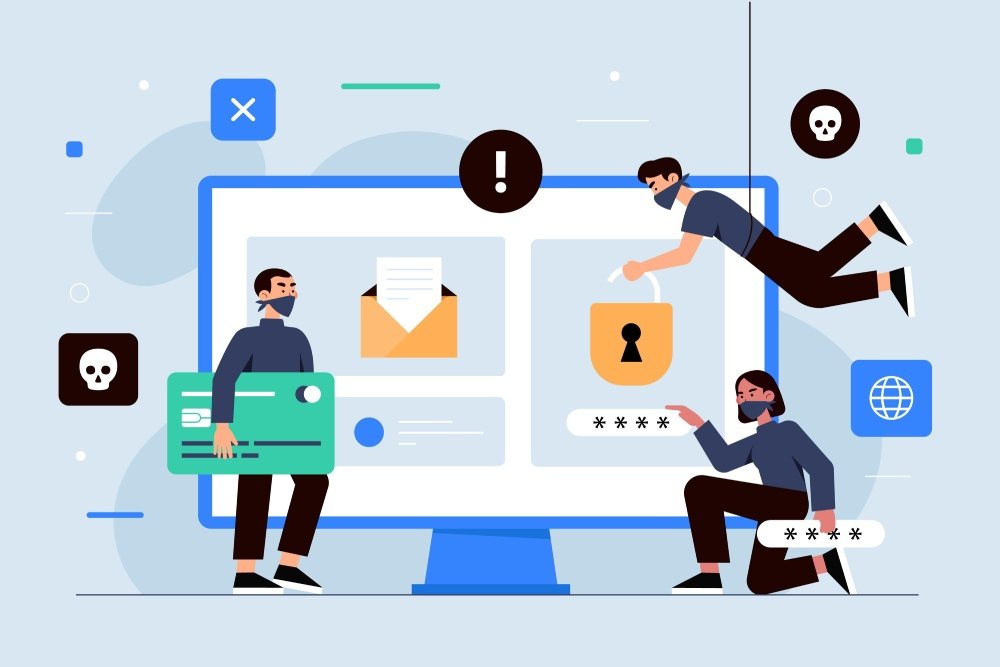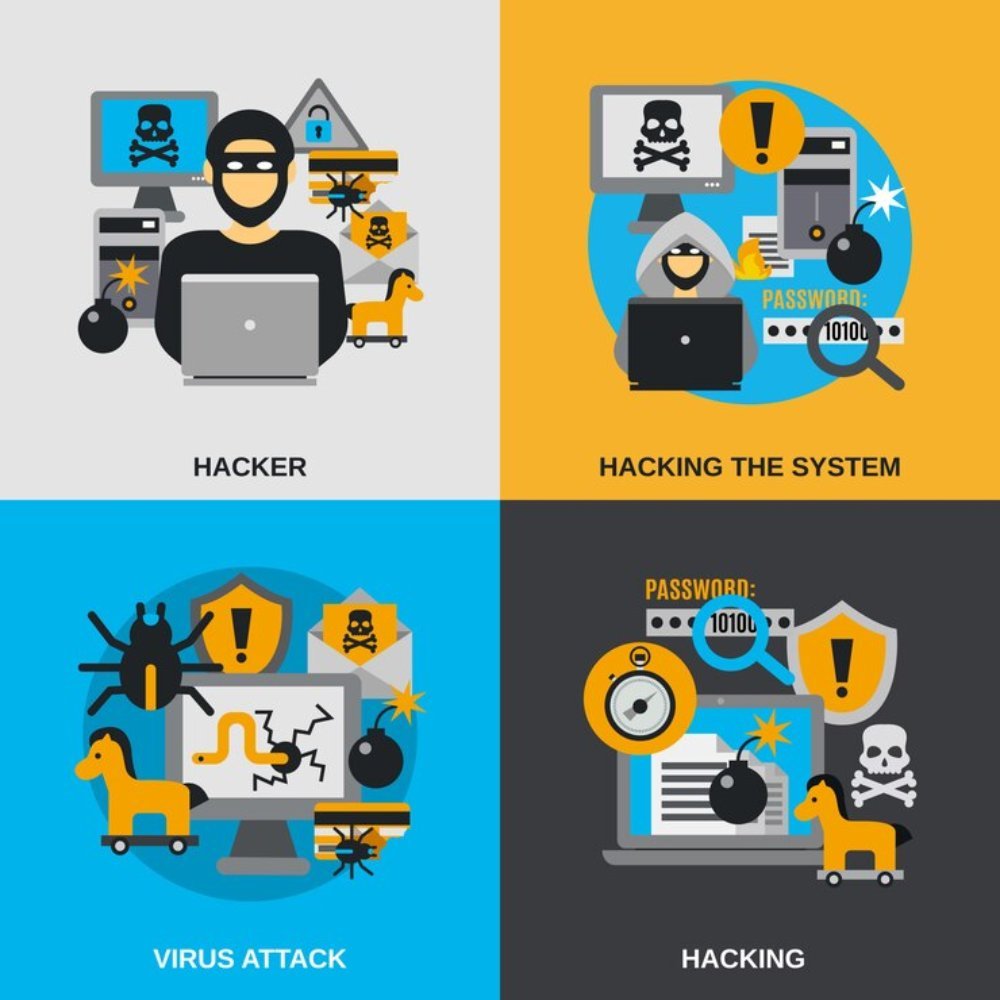
In this digital era, common cyber threats are one of the most prevalent problems among both individuals and business people.
Cyber security isn’t an ethereal thing as times pass by, but rather; it is also leveraging for good and bad purposes.
Some of the common cyber threats involve phishing, ransomware, and so on.
In the below article, we will focus on the 5 most common cyber threats that people and businesses deal with nowadays.
We will go into hackers’ approach and find out ways to shield your and your organization’s information from these common cyber threats.
Table of Contents
ToggleWhat Are The Most Common Cyber Threats?

Cybercriminals are now targeting the weaknesses in cybersecurity defenses in different and inventive ways.
Be it a small company owner or just a personal user of the internet, comprehending these common cyber threats is a crucial element to ensure that your digital existence is secure.
Following are the top 5 common cyber threats:
Malware: The Most Common Cyber Threat
Malware, or malicious programs, is the most common cyber security threats faced by users of different levels. This includes viruses, worms, trojans, and spyware, which represent different types of harmful software.
These kinds of programs are purposely created to infest systems, steal secret information, or nuke devices or networks.
Malware is propagated in one of the most common ways, i.e. through email attachments containing malicious code, or deceptive links which lead to a malware download.
The expansion of the malware begins when it gets successfully executed, at which point it spreads through the system, corrupting data and causing disruption in operations.
Antivirus software is a necessary measure at the moment to prevent the access of malware to all devices.
Routinely updating software, and operating systems, carefully handling emails and downloads, also browsing safe places will decrease the chance of victimization by malware.
Phishing: How To Recognize and Avoid It
One of the most common cyber threats forms is phishing, where the bait lures the individual to give away his/her login credentials, credit or debit card details, and social security information.
Cybercriminals will commonly clothe in as safe and trusted sources, sayings banks and well-known companies as part of their search to risk the intended victims through the handing-over of their personal information.
Phishing attacks often happen by emails, text messages, or phone calls that look real. This phenomenon is rapid with emerging technology.
This correspondence is mostly filled by desperate pleas making offers hard to refuse and warnings of great severity, to convince the victims to take immediate action.
It is of crucial importance to be reasonable in checking the credibility of such communications to avoid disclosure of personal information.
To prevent phishing assaults, it is extreme to be cautious and skeptical towards requests for your information that are sent without your consent.
For email, it’s always advisable to check if the sender is credible.
Also, be skeptical of providing personal information on a website if you are skeptical of the receiving party.
Educating yourself and your employees on phishing, and equipping this knowledge with multi-factor authentication means can also help in handing down phishing attacks.
Ransomware: Understanding and Protecting Against It
Ransomware is a kind of malware that is designed to restrict or lock files on a device.
The victim will not be able to access them unless a ransom payment is made to the attacker via a negotiated channel.
It is a profitable cyber scheme that can inflict on your network catastrophic financial and reputational costs whether you are an individual or a part of an organization.
Often, ransomware attacks are targeted through phishing emails or malicious downloads.
The ransomware virus starts by encoding the files that make them unreadable with a unique secret code.
Only a password can restore access to the files.
The decryption of files is still questionable even in cases where the ransom is paid, not to mention the possibility that the culprit will not hesitate to attack the company once more.
In defending against ransomware, it becomes imperative to always make regular backups of such files and store them either online in the form of secure cloud storage or offline.
Incorporating stringent security protocols, especially strong firewalls, intrusion detection systems, and access controls, can also aid against the remittance of data.
Besides, ensuring that the employees are aware of the ransomware risks and training them to be cautious especially when visiting suspicious sites or opening attachments remains vital in the prevention of ransomware risks.
Social Engineering: Manipulating Human Behavior
Social engineering is a cyber threat that capitalizes on human behavior and the study of psychology to take advantage of people and make them provide sensitive information or perform actions that are helpful to the attacker.
This approach is achieved via the establishment of trust, anxiety, or authority to mislead victims for the sake of gaining unapproved access to information or even systems.
Social engineering tools such as pretexting, baiting, and tailgating are some of the actual methods used.
Pretexting is a kind of deception when a person creates a fake plot or story to appear innocent during the process of extracting secret information from victims.
Using fake applications or software the bad people try to lure the victim by promising some excellent offer or item in exchange for the victim’s personal information.
Tailgating is a kind of pedestrian’ invasion in a restricted area in pursuit of unauthorized entry.
Tailgating is another name for a split-second traffic disaster.
Social engineering attacks can be combated effectively if you build awareness, establish skepticism, and good security protocols.
Employer employees are educated about social engineering techniques and warning signs cautious; strong access controls, implementation, and emphasis on verifying requests before sharing information must be made in counter efforts.
Denial of Service (DoS) Attacks: Disrupting Online Services
DoS attacks practice code injection or some other malicious activities that result in making the magnitude of the traffic where it is not able to establish the connection.
They oversaturated the goal system with thousands of requests greater than it can handle, which eventually prevented the working of that system.
A DoS attack can be performed by including the flow of traffic from numerous sources worldwide (DDos or Distributed Denial of Service attacks), and vulnerabilities in software or network infrastructure.
The reasons for launching DoS attacks may be diverse: from the promotion of certain political ideas to the acquisition of financial gain or just the creation of trouble and damage.
One method to safeguard against DDoS is rolling out strong network security systems, such as firewalls, load balancers, and IPS systems.
The work of tracing through network traffic regularly and frequently conducting vulnerability assessments can be a big help in exposing and neutralization growing risks.
Besides that, having a disaster recovery plan in place, which could help swiftly respond to an overnight DoS attack and continue the running of the business is important as it hinders disruption and business continuity.
How To Avoid Common Cyber Threats?

One of the key ways how cyber threats could be dealt with effectively is through a multi-tiered cybersecurity approach that involves individuals and organizations.
Here are some essential steps to consider: Here are some essential steps to consider:
- Regularly update software and operating systems: To keep software and devices updated, all the vulnerabilities are patched; therefore cybercriminals would not have opportunities to gain access.
- Use strong, unique passwords: Secure password creation and using password managers to store passwords off-site can be a powerful weapon against unauthorized account access by third parties.
- Enable multi-factor authentication: A multi-factor authentication which requires entering more factors than just a password is just another level that one goes through to make sure the virtual world techniques are good enough to protect your information.
- Backup of important data regularly: On the other hand, very often it is that files and data of importance are backed up which is meant to guarantee that in the eventuality of a cyber attack or system failure, they can be recovered.
- Educate employees and individuals: Creating awareness about common cyber threats, deploying the staff with good practices, and building a security culture can reflect to lowering the risk of being the target of attacks.
Tools and Software For Common Cyber Threats
Besides doing what is said in the cyber security practices, the use of cybersecurity tools can also increase your defenses against common cyber security threats.
Here are some essential tools and software to consider against common cyber threats:
- Antivirus software: Powerful anti-malware software provides for the detection and removal of malware, which in turn protects the computer against a variety of online threats.
- Firewalls: Firewalls take the function of a”filter” between your devices and the internet, approving access to certain data or stopping others.
- Virtual Private Networks (VPNs): VPNs provide the encryption of Internet connections and hence secure communication by protecting the data from being stolen.
- Intrusion Detection and Prevention Systems (IDPS): IDPSs review network traffic for any unusual activity and without any human intervention can automatically block or alert administrators of potential threats.
- Encryption software: Encrypting programs decode sensitive information into unintelligible code form. This is only decipherable with the right decryption key, hence making the information still secure.
Conclusion
In this last phase, we can highlight how some common cyber threats are a constant challenge for the modern world.
To effectively combat such common cyber threats it is essential to understand them and employ proactive security measures.
Another key is that having cybersecurity tools and software will give your organization an additional advantage in dealing with these common cyber threats.
Nevertheless, one has to bear in mind that cybersecurity is a continuously ongoing process that should be accompanied by the ability to adapt to it and be aware of the danger it might bear.
Welcome to the era, where a major part of our lives is associated with technology hence it is crucial to be educated on the risks posed by common cyber threats.
Through acquaintance with the most frequent common cyber threats, proactive measures, and growing a culture of cybersecurity we will resemble a powerful cyber deterrent.
We need to keep an eye on what is to come and make sure we are informed.
You May Like Also:
One thought on “5 Most Common Cyber Threats”